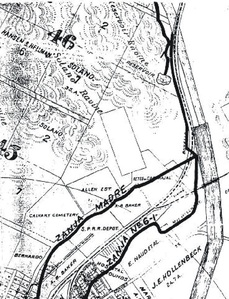|
The water wheel on la Zanja Madre: Part 1  from Olmstead, 1910, after Stevenson, 1876 from Olmstead, 1910, after Stevenson, 1876 Not everyone is aware that there was a water wheel on la Zanja Madre. La Zanja Madre was the ditch that brought water from the Los Angeles River to downtown Los Angeles for more than 125 years. The first zanja was dug almost immetiately after the founding of the pueblo in 1781 because Los Angeles was initially a farming community; agriculture requires a significant amount of water and Los Angeles has a very dry climate.. Eventually, responsibility for the zanja fell to a person known as the zanjero, who was charged with keeping the zanja clear of grasses, obstructions, and dead animals (a lovely image, right? But it's true ...). The zanjero was a public official, responsible for issuing permits to use water from the zanja and collecting use fees from water users. He was paid a salary out of municipal funds. There seems to be a compulsion today on the part of some to refer to la zanja madre as 'the Mother Ditch', but that latter term is simply a literal translation of la zanja madre from the Spanish. Rest assured that no one in early Los Angeles ever called it 'the Mother Ditch', as evidenced by numerous articles in early newspapers dating back to 1854. And the zanjero was always referred to as 'the zanjero'. Remember, Spanish was the lingua franca in Los Angeles until well into the 19th-Century. But about that water wheel ... Water pressure is determined by how high above the outlet the water level is initially. That pressure is about 0.45 pounds per square inch, or 0.45 psi. The higher the column of water, the greater the pressure at the outlet. So a plan was executed to raise the pressure by constructing a water wheel on la zanja madre. In May, 1863, a 30- to 40-foot, wooden water wheel, constructed in San Francisco and brought in pieces by boat to Los Angeles, was put into service on the zanja. Various accounts provide differing numbers as to its diameter.) A 40-foot wheel would have raised the water pressure downtown by nearly 18 psi, which was a significant improvement over the original gravity flow from the river. Fortunately, we know exactly what the water wheel looked like, from a photograph taken circa 1870: The trestle-like structure running to the right from the top of the wheel is a wooden flume that moved the water from the wheel to another ditch that was higher on the hill that is in the foreground of the picture. Of interest to Solaneros is the fact that the vantage point of this photograph is almost directly opposite the bottom of Solano Avenue.
Part 2 of this blog will describe the water wheel in greater detail and pinpoint its location, on both historic maps and a satellite image of the area today. |
About the AuthorLawrence Bouett is a retired research scientist and registered professional engineer who now conducts historical and genealogical research full-time. A ninth-generation Californian, his primary historical research interests are Los Angeles in general and the Stone Quarry Hills in particular. His ancestors arrived in California with Portolá in 1769 and came to Los Angeles from Mission San Gabriel with the pobladores on September 4, 1781. Lawrence Bouett may be contacted directly here.
Archives
July 2018
Categories |


 RSS Feed
RSS Feed
